To maximize your air-purifying plants' performance, you'll need a balanced light spectrum that combines blue (400-500 nm) and red (620-750 nm) wavelengths in a 1:2 ratio. Blue light promotes leaf growth and strong stems, while red light enhances metabolism and overall plant health. Adding a touch of green light helps penetrate deeper into the plant canopy. Understanding the full scope of light management can transform your indoor air quality to new heights.
The Science Behind Light Wavelengths and Plant Health

Light is the cornerstone of plant-based air purification systems. When you're choosing lighting for your air-purifying plants, understanding the light spectrum's role in plant health becomes vital.
Blue light (400-500 nm) drives vegetative growth, helping your plants develop strong stems and lush foliage that's essential for air filtration. You'll find that red light (620-750 nm) complements this process by supporting flowering and fruiting, which increases overall plant biomass and purification capacity.
Full-spectrum lighting offers your plants the complete range of wavelengths they need through different growth stages. It's like providing them with artificial sunlight, ensuring they perform at their peak.
Even green light plays its part, reaching deeper into the plant canopy to maintain the health of lower leaves, maximizing your air purifier's effectiveness.
Essential Light Colors for Air-Purifying Species
You'll find that air-purifying plants perform best under a balanced spectrum where blue light promotes robust leaf development while red light enhances their toxin-filtering capabilities.
When you combine these primary wavelengths with green light, which penetrates deep into the plant canopy, you're creating ideal conditions for maximum photosynthesis and air-cleaning efficiency.
UV light plays a supporting role in this process, strengthening plant cell walls and boosting their natural defense mechanisms, which ultimately improves their air-purifying performance.
Optimal Light For Photosynthesis
When selecting lighting for air-purifying plants, understanding the ideal spectrum is essential for maximizing their effectiveness.
You'll want to focus on providing a balanced light spectrum that includes both blue and red wavelengths. Blue light (400-500 nm) promotes robust leaf growth and root development, while red light (620-750 nm) enhances overall plant productivity and flowering.
To support peak photosynthesis, you'll need to guarantee your plants receive light within the PAR range of 400-700 nm. This full-spectrum approach mimics natural sunlight, giving your air-purifying plants the energy they need to thrive.
When your plants receive the right combination of light wavelengths, they'll perform better at improving your indoor air quality through enhanced carbon dioxide absorption and pollutant removal.
UV Effects On Purification
To maximize your air-purifying plants' effectiveness, incorporating UV light alongside standard growing spectrums can markedly boost their pollutant-filtering capabilities.
When you expose your plants to specific wavelengths, particularly UV-B, you'll trigger stress responses that increase their production of beneficial compounds like flavonoids and terpenes.
Combine UV light with blue light (400-500 nm) to promote robust vegetative growth in your air-purifying plants. This pairing enhances their ability to filter toxins and improve indoor air quality.
You'll want to maintain controlled UV exposure to keep your plants healthy and operating at peak performance.
Red-Blue Balance Benefits
Maintaining the right balance between red and blue light creates an ideal growing environment for your air-purifying plants. The secret lies in understanding how these wavelengths work together, with blue light (400-500 nm) supporting vegetative growth while red light (620-750 nm) enhances flowering and overall vigor.
You'll achieve peak growth by using a light ratio of 1:2 (blue to red). This balance helps your plants produce beneficial compounds that boost their air-cleaning abilities.
If you're growing indoors, full-spectrum LED lights can perfectly replicate natural sunlight, ensuring your plants get the right light exposure they need. By providing your air-purifying plants with this ideal red and blue combination, you'll maximize their effectiveness at removing toxins from your indoor environment.
Blue Light Benefits for Leaf Development
Blue light plays a pivotal role in promoting robust leaf development, operating within the 400-500 nm wavelength range.
You'll notice that plants exposed to blue light develop stronger, more compact leaves with tighter internodal spacing, creating bushier plants with enhanced air purification capabilities.
When you provide your plants with adequate blue light exposure, you're boosting their chlorophyll production, which directly improves photosynthesis efficiency.
The increased leaf thickness and sturdiness that results from blue light exposure helps your plants filter air pollutants more effectively.
If you're using systems like the Verta Air Purifier, you'll want to guarantee proper blue light conditions to maximize your plants' air-cleaning potential.
The denser foliage and improved leaf structure you'll achieve through blue light optimization will greatly enhance your indoor air quality.
Red Light's Role in Plant Metabolism
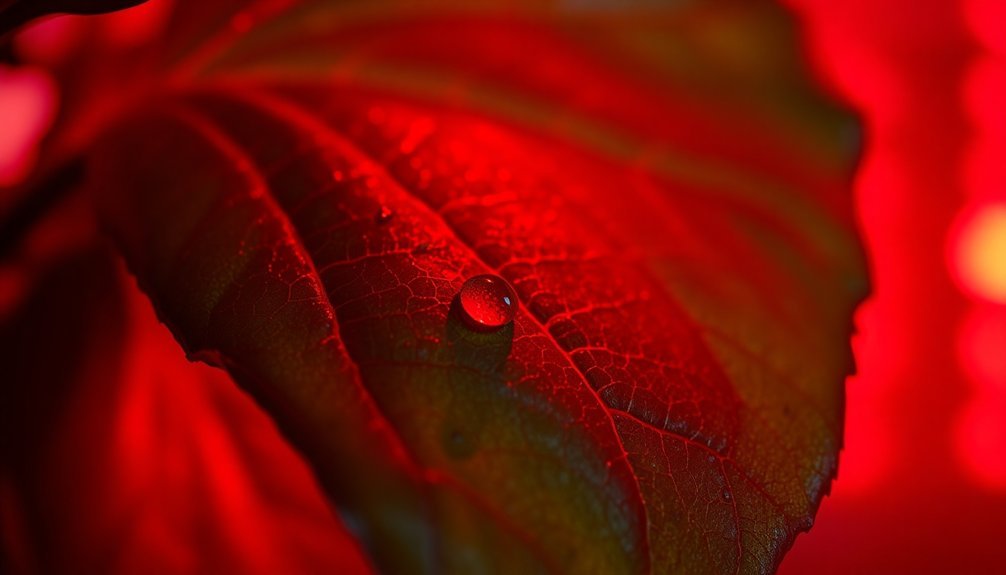
Your air-purifying plants thrive when red light wavelengths activate their photosynthetic response pathways, triggering essential metabolic processes and phytochrome production.
When you expose plants to red light in the 620-750 nm range, you'll notice accelerated growth rates and enhanced chlorophyll development as the plants efficiently absorb and process this specific spectrum.
The red light mechanics work by stimulating the plants' internal systems, boosting their nutrient absorption capabilities, and optimizing their overall metabolic performance for superior air-purifying results.
Red Light Absorption Mechanics
When plants absorb red light wavelengths between 620-750 nm, they trigger essential metabolic processes that drive growth and reproduction.
You'll find that these wavelengths stimulate chlorophyll production, enhancing photosynthesis and enabling your air-purifying plants to convert light into usable energy more efficiently.
Red light interacts with special proteins called phytochromes, which control critical aspects of plant development.
These proteins respond to the light by regulating seed germination and stem growth. Additionally, they help maintain your plant's natural growth cycles by influencing its circadian rhythms.
When you provide ideal exposure to red light, you're supporting fundamental cellular functions that lead to healthier plants with improved yields.
Understanding these absorption mechanics helps you create perfect growing conditions for your air-purifying plants to thrive.
Photosynthetic Response Pathways
Red light triggers a cascade of essential metabolic reactions that enhance photosynthesis in air-purifying plants. When you expose plants to this specific wavelength (620-750 nm), you'll notice improved chlorophyll production, which directly improves their ability to convert light into usable energy.
Your indoor air quality benefits from this process because ideal exposure to red light strengthens plants' metabolic pathways. The light stimulates plant hormones that control growth patterns and flowering development.
You'll see more flowering sites emerge, leading to increased plant productivity and vigor. This enhanced metabolic activity means your air-purifying plants can filter indoor air more effectively.
The red light spectrum's influence on photosynthesis creates a powerful chain reaction: better growth, stronger plants, and ultimately, cleaner air in your space.
Growth Rate Effects
Through specific wavelengths of red light exposure, plants in air-purifying systems experience dramatic growth acceleration and enhanced metabolic efficiency.
You'll notice that red light wavelengths between 620-750 nm trigger essential phytochrome responses, which directly boost plant growth and development rates.
When you're refining your air purification system, red light plays an important role in promoting the flowering phase and increasing photosynthesis efficiency.
This ideal light spectrum enhances carbohydrate production and biomass accumulation, making your plants more effective at cleaning the air.
You'll achieve even better results by combining red light with blue wavelengths, as this combination maximizes metabolic processes.
The enhanced growth rates you'll see aren't just about bigger plants – they translate to more efficient air purification through increased photosynthetic activity and improved overall plant health.
UV Light Effects on Plant Defense Systems
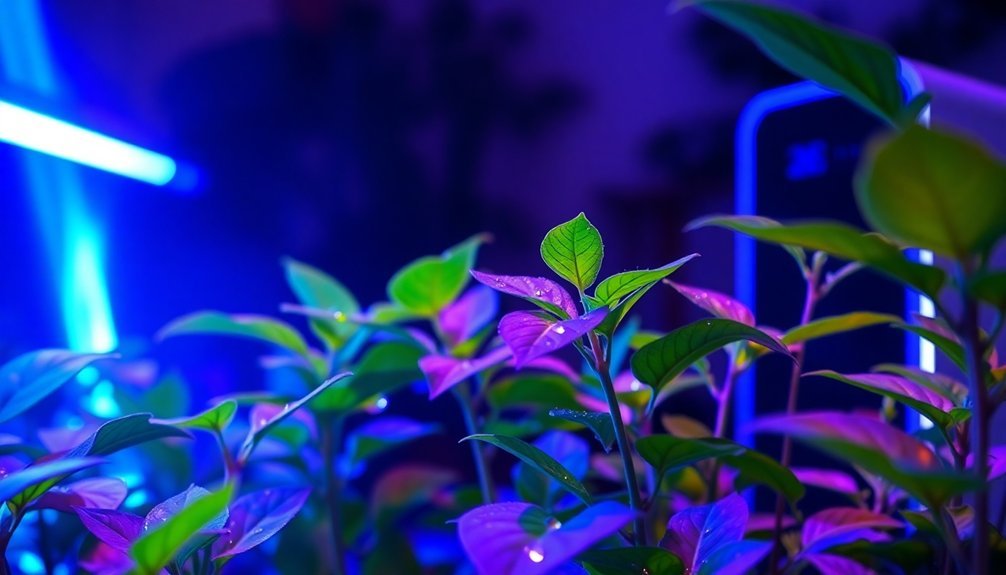
Although UV light can be harmful in high doses, it plays a fascinating role in strengthening plant defense mechanisms. When you expose your air-purifying plants to controlled amounts of UV-B light (280-320 nm), you'll trigger their natural protection systems, prompting them to produce beneficial compounds like flavonoids and terpenes.
These substances help your plants defend against environmental stressors more effectively.
You'll need to be careful with UV exposure, though. While moderate amounts can create sturdier plants with enhanced resilience, excessive UV exposure can damage their DNA and stunt growth.
The key is finding the sweet spot – just enough UV light to activate their defense systems without overwhelming them. By strategically incorporating UV light into your growing routine, you'll help your air-purifying plants develop stronger protective abilities.
Green Light Penetration and Canopy Growth
Light distribution within your air-purifying plants takes an unexpected turn when it comes to green wavelengths (500-600 nm).
While you might think green light isn't essential for plant growth, it actually penetrates deeper into the canopy than other wavelengths, reaching leaves that don't receive direct light.
Green light isn't just supplementary – it's a vital force that reaches deep into plant canopies where other wavelengths can't penetrate.
You'll find that green light creates a more balanced growth pattern throughout your plants. It's particularly effective in dense foliage arrangements, where lower leaves need sufficient light for photosynthesis.
This penetration helps maintain overall plant health and enhances the efficiency of your air-purifying system. As an added benefit, you'll find it easier to spot potential problems like nutrient deficiencies or pest issues under green light.
When you're setting up indoor growing systems, including green wavelengths helps create a prime light spectrum for robust canopy growth.
Optimal Light Combinations for Indoor Purifiers
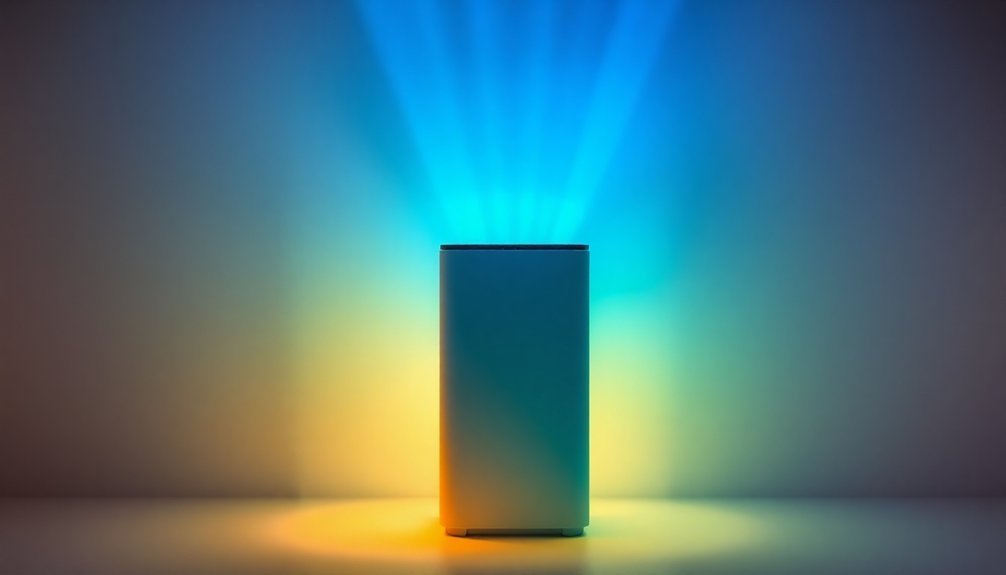
Building on the benefits of green light penetration, you'll want to contemplate the full spectrum of light combinations to maximize your indoor air-purifying plants' effectiveness.
For ideal indoor growing, you'll need to combine blue and red light wavelengths, as they're essential for robust photosynthesis and healthy development.
Full-spectrum lighting is your best choice, as it supports every growth stage from seedling to mature plant. You'll see the most success by providing blue light (400-500 nm) to encourage strong vegetative growth, while red light (620-750 nm) enhances flowering and overall plant health.
To achieve the ideal amount of light, set your lighting schedule for 12-16 hours daily. This timing guarantees your air-purifying plants maintain peak performance while filtering indoor pollutants effectively.
Light Intensity Requirements by Growth Stage
Since different growth stages demand varying levels of light intensity, you'll need to adjust your lighting setup accordingly for perfect air-purifying performance.
During the vegetative stage, provide your air-purifying plants with 32 watts per square foot to encourage strong roots and compact foliage.
When plants enter the flowering stage, increase the intensity to 50 watts per square foot to maximize flower production.
For best growth, maintain consistent light exposure between 12-16 hours daily. This schedule mimics natural sunlight patterns and supports your plants' natural growth cycles.
Keep your grow lights positioned about one foot above the plant canopy – this distance prevents leaf burn while ensuring your plants receive adequate intensity.
Measuring Light Spectrum Performance
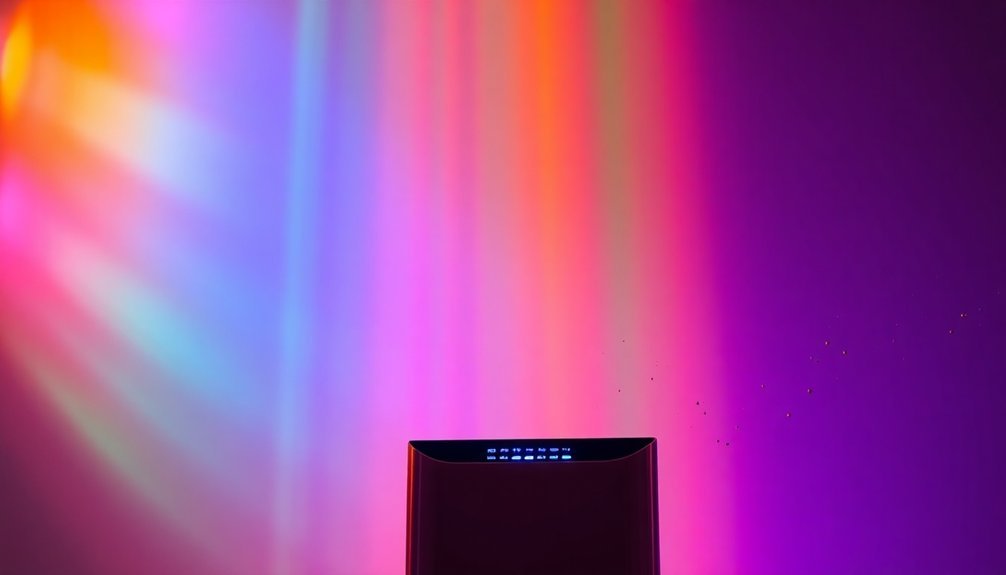
To guarantee your air-purifying plants receive maximum light, you'll need to measure PAR values using specialized meters that detect photosynthetically active radiation in the 400-700 nm range.
You can track light intensity through PPF and PPFD measurements, which provide essential data about the amount of usable light reaching your plants' surfaces.
Regular spectrum analysis helps you maintain perfect growing conditions by identifying any deficiencies in your lighting system and allowing for timely adjustments to support plant health and air purification efficiency.
PAR Values And Standards
Understanding PAR values provides essential benchmarks for measuring light spectrum performance in air-purifying systems. You'll need to monitor your PPFD levels between 200-400 μmol/m²/s during the vegetative stage to guarantee peak growth. Different plant species require varying light intensities, so it's vital to adjust your grow lights accordingly.
| Growth Stage | PPFD Range | Light Duration |
|---|---|---|
| Seedling | 100-200 μmol/m²/s | 14-16 hours |
| Vegetative | 200-400 μmol/m²/s | 16-18 hours |
| Flowering | 400-600 μmol/m²/s | 12 hours |
To maximize your air purifier's effectiveness, you'll want to track the Photosynthetic Photon Flux regularly. This guarantees your plants receive adequate light within the 400-700 nm wavelength range, supporting both their growth and air-cleaning capabilities. Remember, proper light spectrum management directly impacts your system's purification performance.
Light Intensity Testing Methods
Three essential methods help you accurately measure light spectrum performance in air-purifying systems.
First, you'll want to use PAR meters to measure Photosynthetically Active Radiation between 400-700 nm, giving you precise readings in µmol/m²/s to determine best light conditions for plant growth.
Next, utilize spectrum analyzers to evaluate your grow lights' wavelength output. This guarantees you're providing the exact light spectrum your air-purifying plants need for maximum effectiveness.
Finally, implement progressive light intensity testing – start with lower levels and gradually increase them while monitoring plant response.
You'll need to conduct regular measurements to maintain ideal conditions. By tracking these metrics consistently, you can make informed adjustments to your lighting setup, ensuring your plants thrive and your air purifier performs at its peak.
Seasonal Light Adjustments for Plant Success
Since plants naturally respond to seasonal light changes, optimizing your air-purifying system's light spectrum throughout the year is essential for peak performance.
You'll need to adjust your lighting to match nature's rhythms, focusing on blue light during spring and summer to promote vegetative growth, then altering to red light in fall and winter for flowering and increased biomass.
Here's how to implement seasonal light adjustments for your air-purifying plants:
- Increase blue light (400-500 nm) in spring/summer to strengthen roots and foliage.
- Shift to red light (620-750 nm) in fall/winter to encourage flowering.
- Maintain a consistent daily light schedule that mimics natural patterns.
- Monitor light intensity regularly and adjust spectrum settings based on plant response.
Signs of Improper Light Exposure
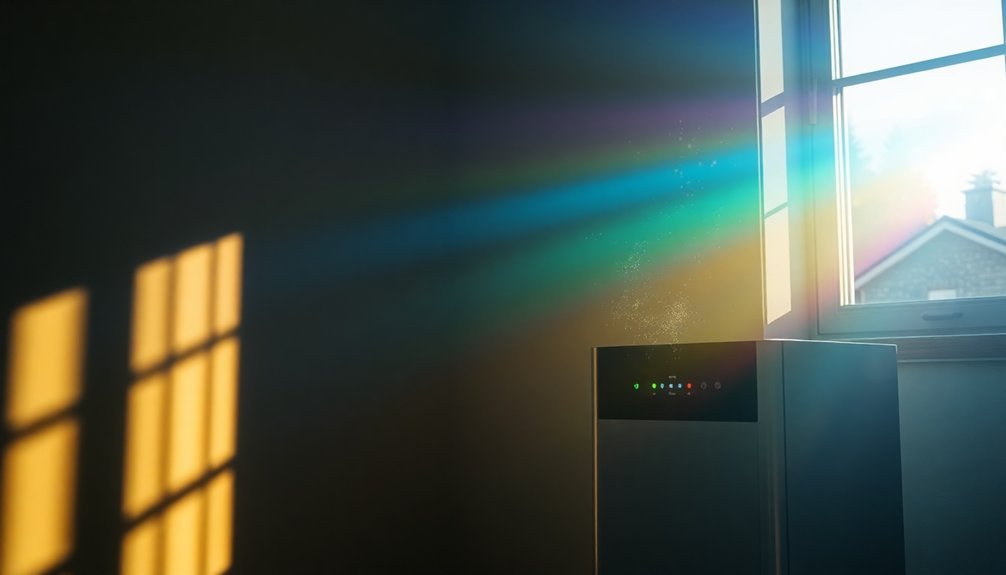
To maintain healthy air-purifying plants, you'll need to recognize when your lighting setup isn't meeting their needs.
Watch for signs of improper light exposure, such as elongated stems and sparse foliage, which indicate insufficient light intensity in your growing space.
If you notice leaf burn or stunted growth, your plants may be receiving too much light, potentially causing DNA damage and disrupting their plant growth cycles.
Pay attention to yellowing leaves and poor development, as these symptoms can signal nutrient deficiencies linked to inadequate light spectrums for proper photosynthesis.
Monitor your plants regularly and adjust their lighting conditions when you spot these warning signs.
Quick identification of light-related stress will help you maintain ideal conditions for your air-purifying plants and guarantee their continued health.
Advanced Spectrum Management Techniques
After identifying light-related stress in your plants, mastering advanced spectrum management can greatly boost their air-purifying performance.
Full-spectrum lighting systems replicate natural sunlight, enhancing photosynthesis and improving your plants' air-cleaning abilities. You'll want to monitor light intensity using PAR meters to maintain the perfect 400-700 nm range.
Proper light spectrum management unlocks your plants' full air-purifying potential through enhanced photosynthesis and optimal PAR levels.
Here's how you can implement advanced spectrum management:
- Use blue light (400-500 nm) during vegetative growth phases to promote healthy leaf development.
- Switch to red light (620-750 nm) when plants enter flowering stages.
- Install automated systems that adjust light spectrums based on plant growth stages.
- Monitor PAR readings regularly to guarantee peak light intensity levels.
These techniques create an ideal environment for your air-purifying plants, maximizing their effectiveness in cleaning indoor air.
Frequently Asked Questions
What Is the Best Grow Light Spectrum?
You'll get the best results using full-spectrum grow lights that combine blue light (400-500nm) for vegetative growth and red light (620-750nm) for flowering. Don't forget green light for deeper canopy penetration.
Is 5000K or 6500K Better for Plants?
You'll get good results with both, but 6500K's cooler, bluer light is particularly effective for vegetative growth and leaf development. If you're focusing on foliage growth, choose 6500K for ideal plant development.
What Color Light Promotes Plant Growth?
You'll get the best plant growth using a combination of blue light for vegetative growth and red light for flowering. Blue promotes strong roots and bushier plants, while red enhances flowering and fruiting.
Should My Grow Light Be Red or Blue?
You'll want both red and blue lights for ideal growth. Blue promotes strong roots and compact leaves, while red enhances flowering. Using a full-spectrum LED that combines both colors will give you the best results.
In Summary
You'll get the best results from your air-purifying plants by providing a balanced spectrum of blue light (400-500nm) and red light (600-700nm). Blue light promotes leaf growth and purifying efficiency, while red light drives photosynthesis and metabolism. Monitor your plants for signs of light stress, and adjust their exposure seasonally. Consider using full-spectrum LED grow lights to maintain ideal conditions year-round.

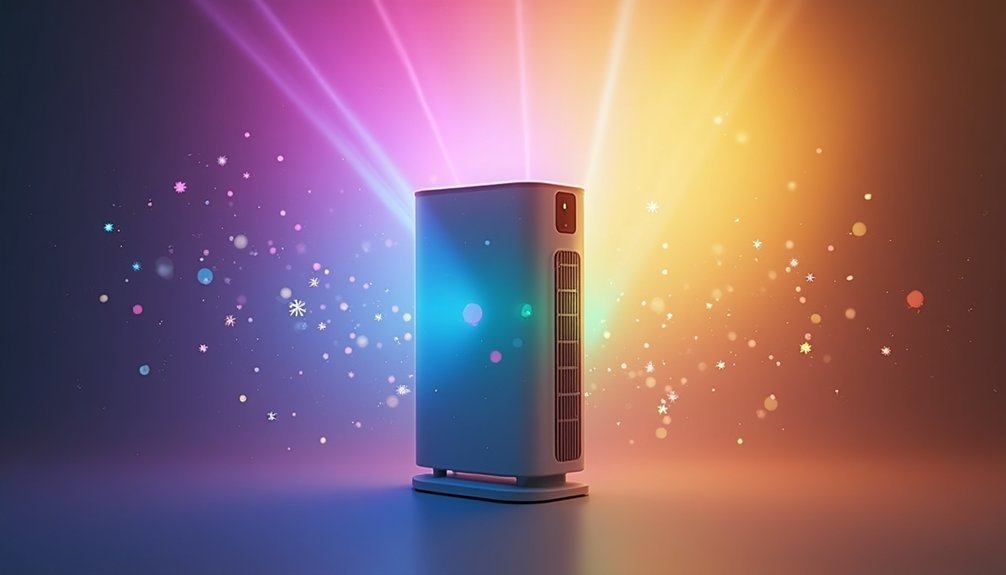



Leave a Reply